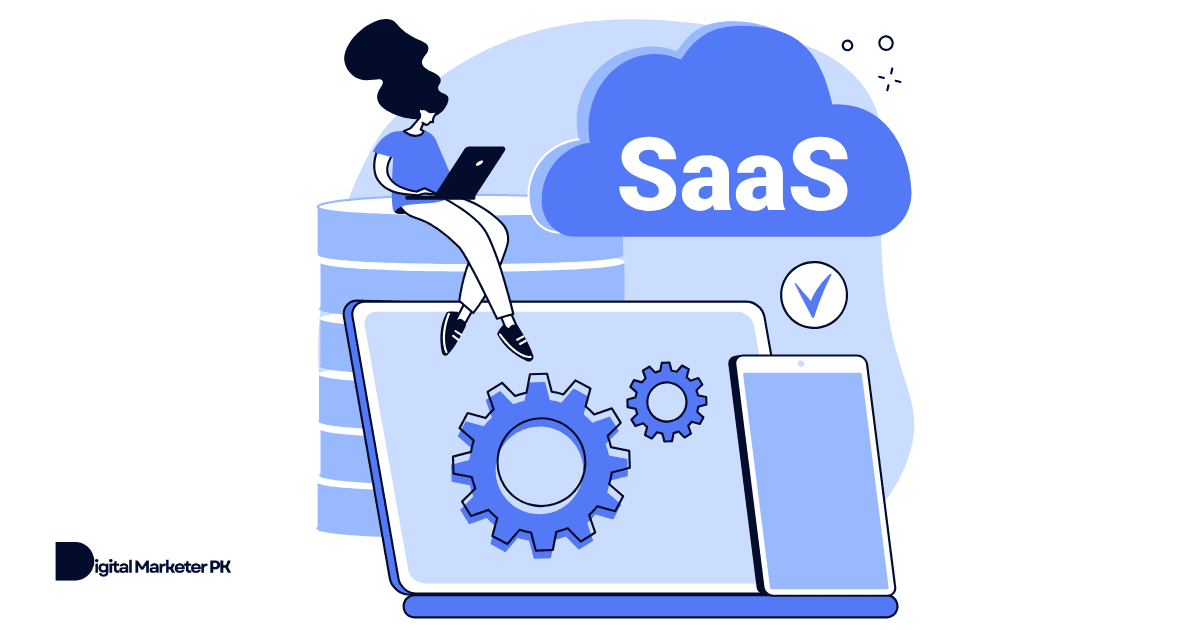If there’s one thing that big SaaS companies have in common is an affiliate marketing program. SaaS affiliate marketing is the real deal.
It’s an exceptionally powerful technique for SaaS companies that want to scale quickly and cost-effectively. SaaS affiliate marketing is the process of partnering with affiliates who generate sales and leads for your SaaS company.
Sounds interesting?
Keep reading as this detailed guide unleashes everything you need to know to grow your SaaS brand with the help of affiliate marketing.
What is Affiliate Marketing?
Affiliate marketing is a performance-based marketing strategy where businesses reward third-party partners (affiliates) for driving traffic, leads, or sales.
Affiliates use unique referral links or codes to direct potential customers to your software. When a referred user takes a desired action—such as signing up for a trial or becoming a paying customer—the affiliate earns a commission.
This win-win model aligns both parties’ interests and encourages sustained engagement.
How an Affiliate Marketing Program Works for SaaS Businesses
A successful SaaS affiliate program follows a structured process that ensures smooth onboarding, effective tracking, and continuous optimization. Here’s how it works:

Recruitment: Finding the Right Affiliates
Recruiting the right affiliates is the foundation of a successful affiliate program. Your SaaS business needs to identify and onboard affiliates who have an audience that aligns with your target market.
These affiliates can include:
- Influencers in the SaaS or tech space
- Niche bloggers who write about software solutions specifically in your niche
- Industry experts and consultants
- Existing customers who are advocates of your brand.
Selecting high-quality affiliates ensures that referrals come from trusted sources which significantly increases your conversions.
Tracking: Assigning Unique Affiliate Links
Once affiliates are onboarded, they need a way to track their referrals.
This is typically done using unique tracking links known as affiliate links. You have a few different options to create affiliate links for your affiliates:
- Use an affiliate network such as CJ
- Create an affiliate program in-house
- Use a link tracking tool to accurately track URLs for attribution.
The best option is to start with an affiliate network (more on this below) as it saves cost and is trustworthy.
Accurate tracking is essential for ensuring fair payouts and gathering insights into which affiliates perform best.
Promotion: Driving Traffic and Engagement
Affiliates promote your SaaS product through a wide range of agreed upon marketing channels such as:
- Blog posts with software reviews or tutorials
- Email newsletters recommending your product
- Social media posts with engaging content and referral links
- YouTube videos or webinars showcasing your app.
Providing affiliates with high-quality marketing collateral—such as banners, pre-written content, and video assets—helps them promote your SaaS more effectively.
It also gives you more control over how your SaaS is marketed.
Conversion and Payout: Rewarding Affiliate Success
When a potential customer clicks on an affiliate’s referral link and completes a desired action—such as signing up for a free trial, subscribing to a paid plan, or making a purchase—the affiliate earns a commission.
The payout model can vary:
- One-time commission: A fixed amount per conversion
- Recurring commission: A percentage of monthly subscription fees for the customer’s lifetime
- Tiered commission: Higher payouts for affiliates with more sales.
You can select different payout models for a single affiliate program. What’s important is that affiliates should be paid on time to keep them hooked.
Optimization: Analyzing and Improving Performance
A successful SaaS affiliate program requires continuous optimization:
- Which affiliates are bringing in the most conversions?
- Which marketing channels are performing best?
- Customer behavior and retention rates from affiliate-driven traffic.
These insights help you in refining commission structures, adjust promotional strategies, and offer incentives to top-performing affiliates to maximize ROI.
The data also helps you better understand your target audience and refine and tweak your SaaS product.
Benefits of Using Affiliate Marketing for Your SaaS
Implementing a SaaS affiliate marketing program offers numerous advantages. Here’s is a list of the primary benefits that your SaaS business can enjoy:
Cost-effective Way to Generate Sales
You pay for results and this significantly reduces marketing cost of your SaaS business.
As much as 65% of retailers report a revenue increase of 20% or more from affiliate channels highlighting its cost-effectiveness.
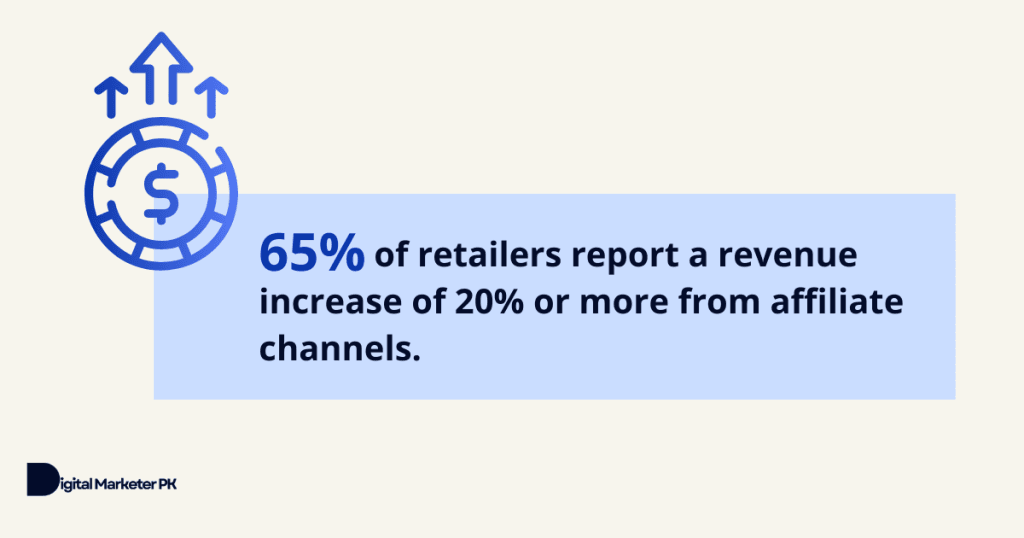
Affiliate marketing operates on a performance-based model where you only pay commissions when a sale or desired action occurs. It minimizes upfront marketing expenses and ensures that your budget directly correlates with results.
Brand Awareness and Reach
Affiliate marketers introduce your SaaS product to new and diverse audiences that you can’t reach otherwise. For instance, an email list of an influencer or a closed community of a blog.
Canva, for example, leveraged affiliate partnerships to build a network of over 9,000 partners that include bloggers and influencers. This significantly amplified its global reach.

Targeted Leads
SaaS affiliate marketers often specialize in specific niches which allows them to send highly targeted traffic. This relevance increases the likelihood of conversions as the audience’s interests align closely with your SaaS product.
Easyship, for example, diversified its affiliate marketers to reach niche markets which resulted in a 312% increase in revenue and 577% higher conversions.
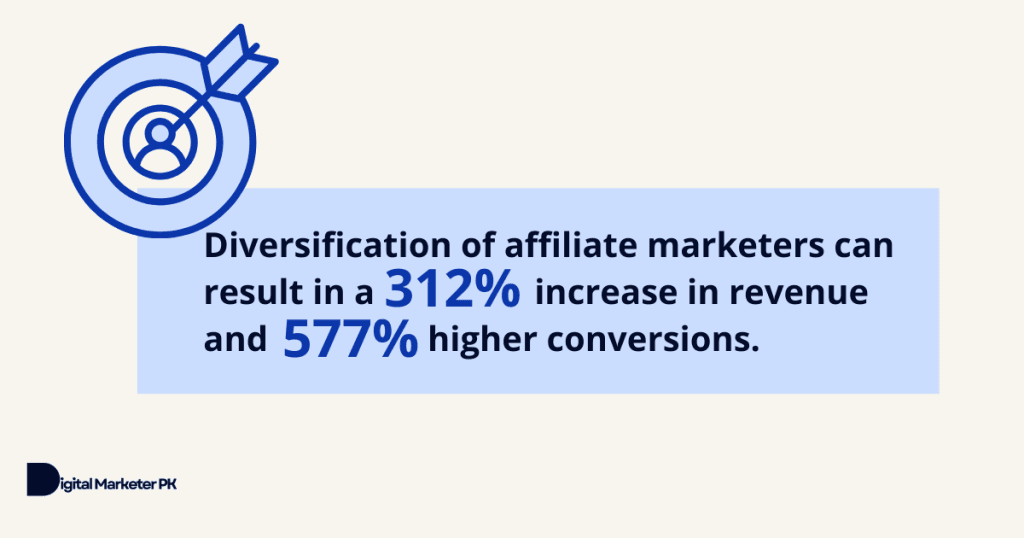
This though, in part, depends on how smartly and accurately you have partnered with affiliate marketers for your SaaS company. It’s your job to find the most relevant affiliates and onboard them based on their target audience’s relevance with your target market.
Trust and Credibility
Recommendations from trusted affiliates can enhance your brand’s credibility. Because consumers, in general, are more inclined to try a product endorsed by someone they trust.
During Cyber Monday 2024, products promoted via affiliate links were 6x more likely to generate a sale compared to non-affiliate content.
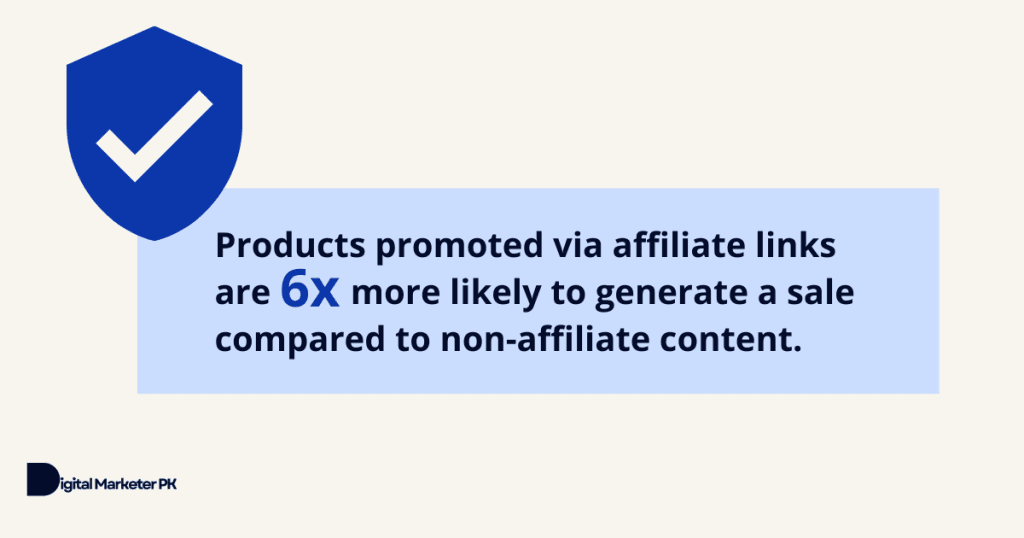
Better SEO
Affiliate marketing can improve your search engine rankings significantly.
Quality, relevant backlinks and brand mentions from affiliate marketers play a massive role in improving your site’s search visibility.
A well-structured SaaS affiliate program where you encourage your affiliates to create content that links back to your SaaS site can boost domain authority and search visibility.
Networking
Building relationships with affiliates can open doors to additional partnership opportunities such as co-marketing initiatives and product collaborations.
For example, Zenefits expanded its partnerships to include publishers and agencies that resulted in a 96% increase in lead volume.
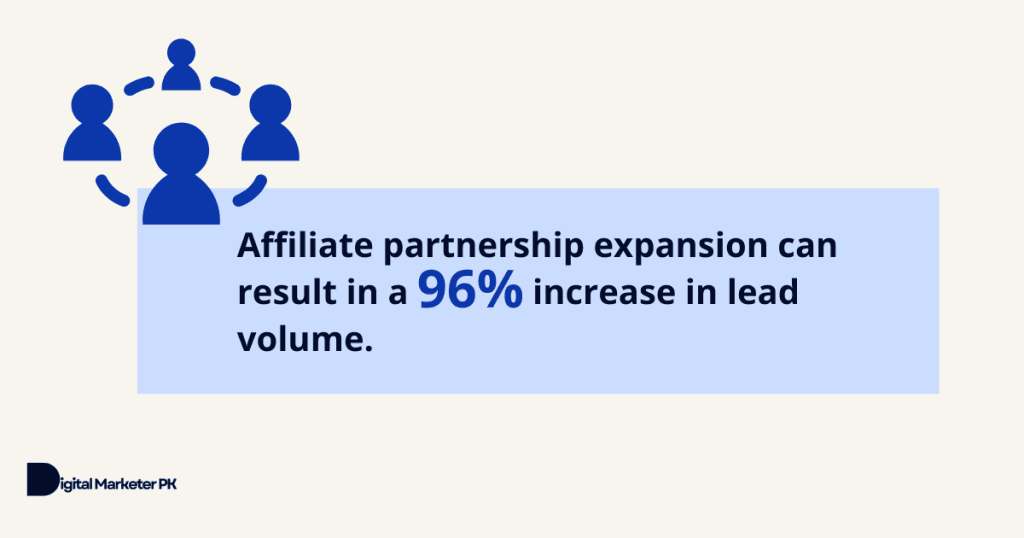
These relationships can lead to mutually beneficial projects that further expand your reach and resources.
Access to Valuable Insights
Affiliate programs provide data on customer behavior and preferences through affiliate-driven traffic. The data helps you figure out what works and why it works.
You can leverage affiliate marketing insights to improve your brand’s targeting and overall marketing.
Trackable Results
Advanced analytics tools enable precise tracking of affiliate performance. It helps you measure ROI effectively.
Research shows that 75% of marketers use dedicated affiliate marketing software for tracking, customization, and transparency.
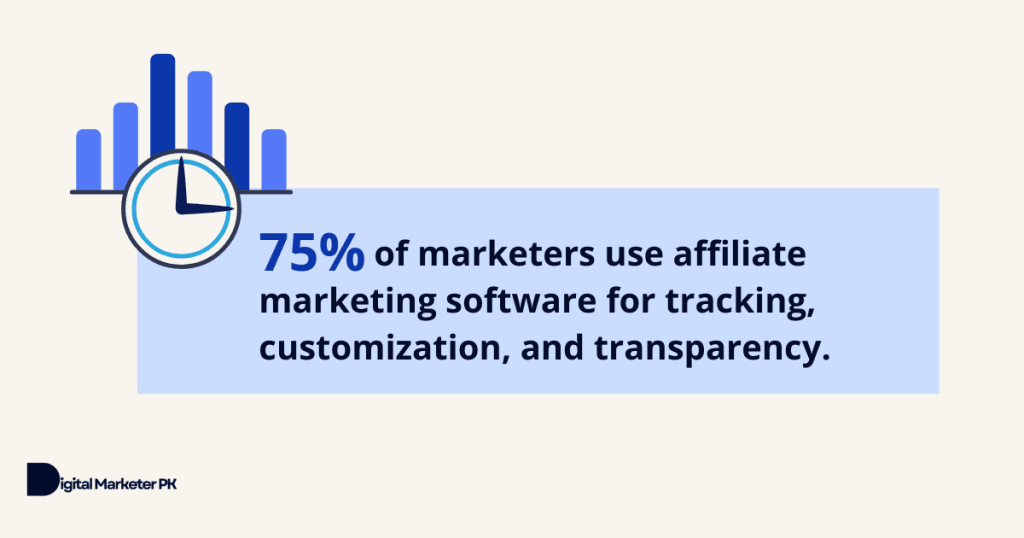
This transparency ensures that you can identify top-performing affiliates and optimize your SaaS affiliate marketing program accordingly.
High Profitability (Low CAC)
Affiliate marketing for SaaS businesses can lead to a lower customer acquisition cost (CAC) since commissions are paid only upon successful conversions. This efficiency contributes to higher profit margins.
You don’t have to spend money on acquiring customers. You only pay commission for successful customer acquisitions this reduces CAC and lowers your marketing cost significantly.
Consequently, your SaaS becomes highly profitable.
SaaS Affiliate Program Examples
Here are the best SaaS affiliate marketing programs that’ll help you understand the potential and strength of affiliate marketing for SaaS:
Unbounce

Unbounce, a leading landing page builder, offers an affiliate program that provides partners with a 35% recurring commission for every referral. The program’s success is evident in Unbounce’s substantial user base growth, attributed in part to the efforts of its affiliates.
Shopify
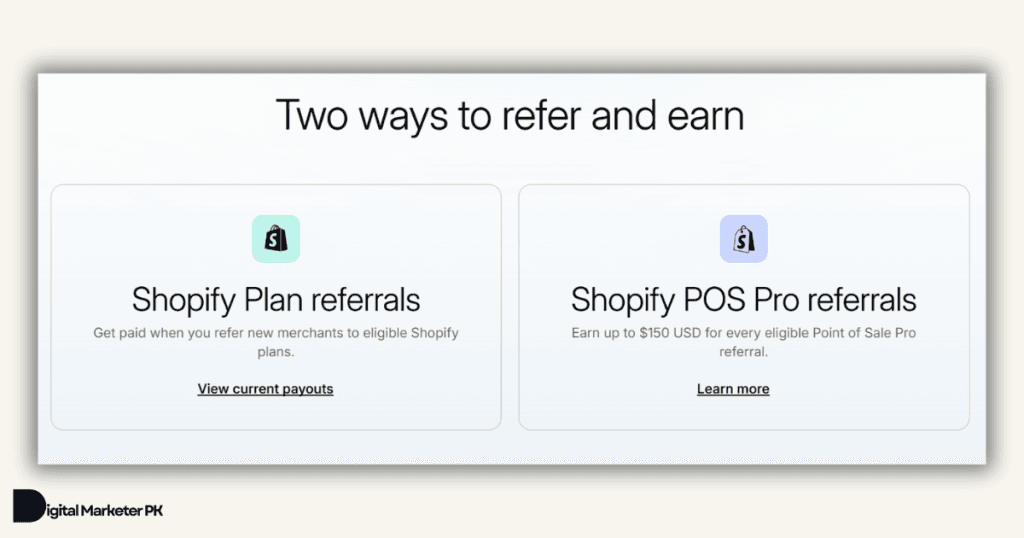
Shopify’s affiliate program offers up to $150 per referral for Shopify plan. This program has been pivotal in establishing Shopify as a leading e-commerce platform.
Affiliates, including bloggers, influencers, and educators, create content that demonstrates how to build and scale online stores using Shopify. This content-driven approach has significantly increased Shopify’s reach and user engagement.
Kit

Kit is an email marketing platform for creators that offers a compelling tiered affiliate program with a 50% commission for 12 months along with recurring commission of up to 20%.
It has been instrumental in driving Kit’s growth, as affiliates—many of whom are creators themselves—share their positive experiences and strategies for using the platform.
The peer-driven promotion has led to a loyal customer base and increased subscription rates.
How to Set Up a SaaS Affiliate Marketing Program
Building a successful affiliate marketing program involves careful planning and ongoing management. Here’s a step-by-step roadmap:
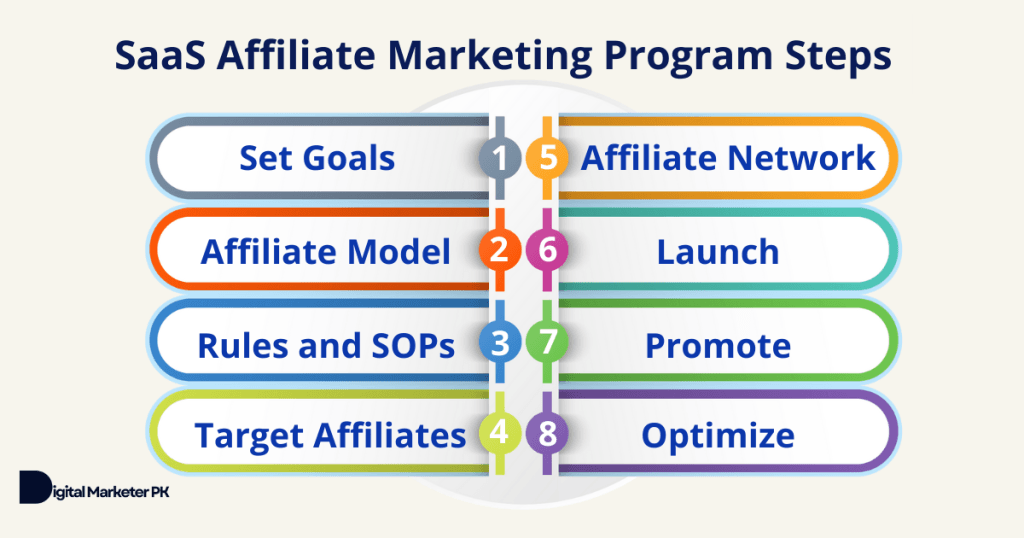
Step #1: Set Affiliate Marketing Goals for Your SaaS Business
Before launching an affiliate marketing program for your SaaS business, it is crucial to define clear goals that align with your business objectives.
Start by determining what you want to achieve with affiliate marketing. This could be:
- Leads
- Free sign ups
- Sales
- Revenue
- Lower CAC
- Traffic
- Brand awareness
- Reach.
The best goal type for SaaS businesses is lead generation as it keeps things quite simple.
- You can track and attribute new leads easily
- It doesn’t involve paying recurring commission to affiliates or one-time high commissions
- You can maintain your control over lead nurturing process by setting the right expectations upfront. Affiliates tend to create hype and end up setting fairly high expectations that lead to negative brand image.
The best way to set goals for any strategy is via SMART framework. It’s my favorite.

Here’s an example of a SMART goal:
“To generate 1,000 qualified leads through affiliate marketing program in 2 months by onboarding 50 high-performing affiliates. We’ll provide them with exclusive promotional materials and offer a $5 commission for every lead that converts into a trial user. We will track progress weekly using affiliate dashboard and adjust tactics as needed to ensure the target is met.”
- S (Specific): Generate 1,000 qualified leads through affiliate marketing program.
- M (Measurable): Track the number of leads generated weekly. Number of new leads is a trackable metric.
- A (Achievable): Onboarding 50 affiliates and offering competitive incentives makes the goal realistic.
- R (Relevant): Lead generation aligns with the company’s growth objectives and revenue goals.
- T (Time-bound): Achieve the goal within 2 months.
Step #2: Choose Affiliate Model and Commission Rate
Selecting the right affiliate model and commission structure is essential for attracting quality affiliates and ensuring profitability.
Decide whether you will offer a one-time payout for referrals or a recurring commission based on subscription renewals.
A recurring commission model is often preferred in SaaS as it motivates affiliates to bring in long-term customers. Since subscription pricing model is the most used SaaS pricing strategy, it’s best to offer affiliate recurring commissions.
It has two benefits:
- It gets easy to recruit affiliates because recurring commissions are lucrative
- Affiliates send warmed up leads that are more likely to stay with your app. That’s how they earn recurring commission.
One-time payout is a great option for SaaS businesses that have a highly engaging app with high CLV. If you know a good chunk of customers stick with your platform and don’t leave your app, you should consider one-time affiliate commissions.
In this case, all you need is new customers and you can hook them yourself.
For new SaaS businesses, this might not work too well.
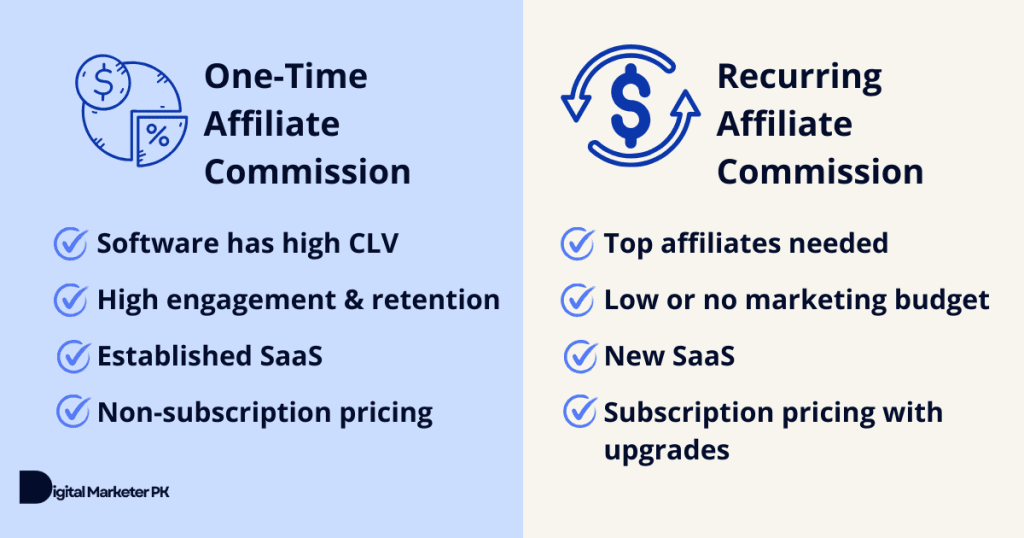
Affiliate Payout Models
A payout model defines how and when an affiliate is paid. You can choose from a wide range of payment models:
- Cost per action (CPA): Most popular model where you pay an affiliate when their user completes an action such as form submission.
- Cost per lead (CPL): Affiliates are paid for generating leads.
- Cost per install (CPI): You pay affiliates when users install or download or use your software.
- Cost per sale (CPS): Affiliates are paid when their referred users become your customers.
- Cost per click (CPC): A bit tricky, but you can use CPC to drive traffic to your SaaS landing page.
- Revenue share (RevShare): You share revenue percentage with the affiliates.

Choose a commission model that aligns with your goal.
For instance, if your goal is to generate sales through affiliates, CPS is the right model to go with. If you are aiming to generate traffic and brand awareness, CPC is a more suitable commission model.
It all comes down to your primary goal.
Step #3: Develop Rules and SOPs for Affiliates
A well-structured affiliate program requires clear rules and standard operating procedures (SOPs) to maintain consistency and prevent misuse.
You need to develop a comprehensive affiliate agreement that outlines acceptable promotional methods, payout terms, marketing channels, content guidelines, PPC and bidding terms, and other details.
Create clear guidelines for affiliates. Tell them what they can and cannot do when promoting your SaaS.
Here’s an overview of what to include in affiliate marketing rules and procedures:
- Affiliate eligibility criterion
- Cookie details
- Validity and acceptance of affiliate terms
- Commission
- Payout
- Branding guidelines
- Allowed marketing channels
- Restricted marketing channels
- Marketing collateral
- Termination and program closure.
You need to create a comprehensive affiliate program agreement that covers pretty much everything about your SaaS affiliate program.
Here’s an example of affiliate program agreement:
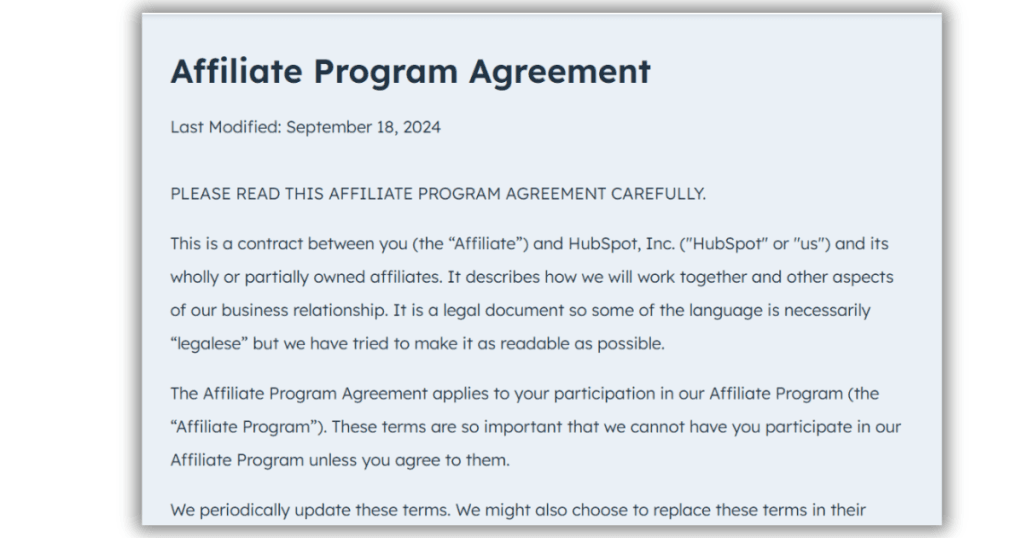
The best way to ensure affiliate marketers follow guidelines and rules is to educate and train them. Create a structured onboarding process for affiliates.
This is one reason why an affiliate marketing tool works best because it makes this part much easier.
Step #4: Define Your Target Affiliates
Get clear on the type of affiliates you want to recruit and work with.
Define your target affiliate based on your niche, app, and other variables.
For instance, if you are selling a B2B marketing software, you need to partner with affiliates who can send business customers your way.
Your target audience should align with the audience of the affiliate marketers you are working with.
It is essential.
You can partner with different types of affiliates:
- Influencers
- Bloggers
- Niche experts
- Subject matter experts
- Content creators
- Website owners
- Businesses in relevant niches
- Local celebrities.
The list can go on and on.
You need to do two things to ensure you work with right affiliate marketers who won’t send irrelevant leads your way:
- Create a customized and detailed affiliate persona
- Develop a rigorous vetting process.
Step #5: Select an Affiliate Network (or Develop In-House)
You can either join an existing affiliate network or build an in-house affiliate program.
Affiliate networks like Impact, PartnerStack, and CJ Affiliate provide access to a vast pool of potential affiliates and offer built-in tracking and payment solutions. These platforms do the heavylifting and make it easy to create and run a SaaS affiliate program.
The downside is that it doesn’t offer a lot of flexibility that you get with a custom-made affiliate program.
If you have the budget and technical resources, go ahead with an in-house affiliate program. It allows you to have full control over tracking, payouts, and relationships with affiliates.
It is an expensive route, but its scalable and long-term approach.
If you are new to affiliate marketing for SaaS, it’s best to stick with a popular affiliate marketing platform. See how it works for your business.
You can switch to custom affiliate program later.
Step #6: Launch Your SaaS Affiliate Program
Once the structure is in place, officially launch your program by creating a dedicated landing page that outlines its benefits, commission structure, and sign-up process.
You need to have everything ready upfront before you launch your affiliate program. These include:
- Affiliate agreement
- Terms and conditions
- SOPs and rules
- Commission and payments
- Landing page
- Affiliate onboarding process
- Bandwidth and resources to track incoming traffic and leads.
Step #7: Promote Your Affiliate Program
Launching your affiliate program for SaaS is the beginning.
The real fun begins once your affiliate program goes live.
You need to market it. You need to recruit affiliates.
And this is the hard part.
One benefit of using an affiliate platform is that you get instant access to a lot of affiliates who are signed up with the affiliate marketplace.
However, most of these affiliates aren’t worth working with.
You’ll still need to promote your program yourself.
Here’s how to market your SaaS affiliate program to recruit quality affiliates:
- Create a dedicated affiliate program page on your website and make sure its visible to visitors
- Send out an email to existing customers and business partners informing them of your affiliate program
- Manually outreach to relevant bloggers, sites, influencers, and content creators. Even if they don’t consider themselves as “affiliates”, you need to connect with them and share program details with them. Since it’s a nice earning opportunity, most of them will join willingly
- Run a PPC campaign on Google Search and social media platforms
- Promote your affiliate program on your brand’s social media accounts regularly.
Step #8: Track and Optimize Performance
A successful affiliate program requires continuous monitoring and optimization.
You might not get instant traction.
It needs a lot of tweaking at multiple levels ranging from affiliate hunting to right commission structure to right model and more.
Monitor your affiliate program regularly. Use relevant metrics to monitor progress and adjust your strategy and program if things aren’t moving as expected.
Affiliate marketing program for SaaS is tricky to get started with. Don’t panic and stick with the plan.
Best SaaS Affiliate Marketing Software for SaaS Businesses
Implementing an effective affiliate marketing program is crucial for SaaS companies aiming to expand their reach and boost sales. Here’s a list of the best affiliate marketing platforms you can use to grow your SaaS exponentially:
1. Impact
Impact is a comprehensive partnership management platform that is a great option for SaaS businesses that are looking to setup their affiliate program. It offers tools to discover new partners, automate workflows, and manage contracts efficiently.
You can automate partner (affiliate) onboarding, track real-time performance metrics, and detect and protect your SaaS affiliate program from frauds.
Key Features
- All-in-One Partnership Management: Integrates various partnership types into a single platform for streamlined operations
- Cross-Channel Attribution: Provides insights into performance across multiple channels to optimize marketing strategies
- Global Compliance Management: Ensures adherence to international regulations, facilitating seamless global operations.
2. Rewardful
Rewardful is a specialized affiliate tool for SaaS companies. It offers seamless integration with payment platforms like Stripe and Paddle. It simplifies the creation of affiliate and referral programs and offers advanced features like affiliate segmentation and customizable affiliate portal.
It has everything you need to initiate an affiliate program for your SaaS business.
Key Features
- Recurring Commission Tracking: Monitors ongoing subscriptions to ensure affiliates receive accurate, timely payouts
- Automated Payout Management: Streamlines the payment process and minimizes administrative overhead
- Simple Integration: Quickly connects with existing payment systems letting you get started instantly.
3. Refersion
Refersion is an all-in-one affiliate platform designed to manage every aspect of an affiliate program for SaaS companies. Its user-friendly dashboard provides real-time metrics and conversion tracking.
Key Features
- Affiliate Marketplace Access: Connects businesses with a vast network of potential affiliates to expand reach
- Real-Time Reporting: Delivers up-to-date insights into affiliate performance and sales data
- Customizable Commission Structures: Allows SaaS businesses to set tailored commission rates and incentives.
4. PartnerStack
PartnerStack is designed to accelerate growth by managing various partner programs such as affiliates, resellers, and referrals. It focuses on automating partner onboarding and engagement processes. It’s an ideal platform for B2B SaaS companies.
Key Features
- Automated Workflows: Simplifies the process of bringing new affiliates on board with clear guidance
- Performance Incentives: Offers tools to create and manage incentive structures that motivate affiliates
- Comprehensive Analytics: Provides insights into partner performance to inform strategic decisions.
5. Tapfiliate
Tapfiliate is a cloud-based affiliate and referral tracking software that lets SaaS businesses set up and manage affiliate programs with ease. It is simple, effective, and easy-to-use affiliate platform.
It’s user-friendly setup and comprehensive tracking capabilities make it suitable for SaaS businesses looking to expand their reach through affiliate marketing without extensive technical overhead.
Key Features
- Customizable Dashboards: Allows SaaS brands to tailor the interface to monitor key metrics effectively
- Multi-Channel Support: Tracks affiliate performance across various channels giving you a holistic view
- Fraud Detection: Implements measures to identify and prevent fraudulent activities within the affiliate program.
6. LeadDyno
LeadDyno specializes in affiliate management with a focus on ease of use and rapid deployment. It offers real-time analytics and integrates seamlessly with leading platforms to track referrals and sales.
You can launch and manage affiliate programs effortlessly for your SaaS company. It offers all the tools you need to monitor performance and optimize your SaaS affiliate program.
Key Features
- One-Click Integrations: Supports over 25 tools and apps allowing you to connect your existing tech stack effortlessly
- Automated Commission Payouts: Simplifies the payment process to affiliates with timely and accurate disbursements
- Comprehensive Analytics: Provides insights into traffic sources, conversion rates, and affiliate performance.
7. CJ Affiliate
CJ Affiliate, formerly known as Commission Junction, is a global affiliate marketing network that connects businesses with a vast pool of affiliates. It offers advanced tracking and comprehensive reporting tools to manage and optimize affiliate programs.
The best thing about CJ Affiliate is its huge marketplace and network of affiliates that lets you find right affiliates quickly.
Key Features
- Global Affiliate Network: Provides access to a wide range of affiliates making it easy to reach best affiliates
- Advanced Tracking Technologies: Utilizes cutting-edge tracking methods to ensure accurate attribution of sales and leads
- Detailed Reporting Tools: Offers in-depth analytics to assess program performance and inform strategic decisions.
Final Words
A well-executed SaaS affiliate marketing program can unlock new revenue streams, expand your reach, and offer measurable performance improvements—all at a cost that directly correlates with results.
All by setting clear goals, choosing the right partners and software, and continuously optimizing your affiliate strategy.
Affiliate marketing is a scalable and sustainable marketing strategy for your SaaS business. If you haven’t explored it yet, it’s time you do.



